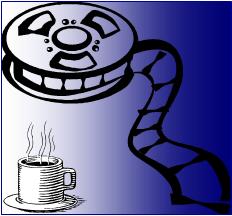

|
 |
Dances with Wolves
|
Please go to the new Coffee Coaster site implemented more gracefully in Wordpress. This page: http://brianrwright.com/CoffeeCoasterBlog/?p=5524 |
Kevin Costner ... Lieutenant Dunbar
Mary McDonnell ... Stands With A Fist
Graham Greene ... Kicking Bird
Rodney A. Grant ... Wind In His Hair
Floyd 'Red Crow' Westerman ... Ten Bears
Ten Bears: Let us smoke a while.
John Dunbar: [voiceover] With Ten Bears, it was always more than a while. There was purpose in everything he did, and I knew he wanted me to stay. But I was sure of myself. I would be an excuse, and that's all the Army would need to find this place. I pushed him as far as I could to move the camp. But in the end, he only smiled and talked of simple pleasures. He reminded me that at his age, a good fire was better than anything. Ten Bears was an extraordinary man.
Sometimes we forget how great some movies are. Dances with Wolves feels as if it were flickering on the big screens of America yesterday, not 19 years ago. It's been sitting on my DVD rack for a long time, and I figured would make a fitting viewing for a Labor Day evening. Captivating is a word that's been overused, as is magic, but the scale, natural beauty, and plot of this film transcend the extraordinary. It also received seven Oscars, including Best Picture and Best Director (Kevin Costner). That's big potatoes in anybody's book.
Thinking back and with our familiarity with Kevin Costner, it's easy to put on one's analytical cap and say, "Well, Kevin Costner always 'plays the same role' as an actor, no matter what the movie." Or reading the tabloids, "The man is such a hound," meaning he at one time may have indulged a sex craving for beautiful women—are there any other kind in Hollywood?—that few other young men had the opportunity for. And perhaps, as with Governor Arnold in his dastardly days, the sex may have bordered on or even been unwanted.[1] Or may not have.
In Costner's case, I feel we have to suppress this familiarity reflex—which after all has a dubious foundation in fact—and take the man in the full measure of his creative trajectory. Certainly, Dances is the magnum opus of his film career, at least as a director. It was Kevin Costner who read the novel by Michael Blake and projected it onto the screen of his mind in living, moving color along with all the majestic music and the unending ocean of grassland that was once the American West. Then he had the genius, acumen, and drive to produce (with Jim Wilson) the movie.
No need to dwell more on Kevin, the work on the screen speaks volumes for itself. Of the perhaps 70-80 DVDs that occupy my carousels, probably 10-20 of them I regard as eminently watchable multiple times. [I've probably seen the Jason Bourne trilogy—Identity, Supremacy, Ultimatum —a total of seven times, Lone Star a dozen, Clueless fifteen, and so on. And Lonesome Dove I've seen in its entirety once a year since it debuted in 1989.] But for some reason, I've neglected to multiple-play Dances with Wolves. I think part of that reason is the same argument that people used to give for not watching The Waltons (1972-1981) on TV:
We're going to watch people conduct their daily lives in the neighborhood and environment where they live? Do we really care that John Boy wants to be a writer, or (in the case of Dances) that John Dunbar (Kevin Costner) keeps a diary of his day-to-day experience with the Lakota Sioux Indians out in the middle of Bleepin' Nowhere? What's the conflict? Where's the excitement?
But every once in a while I remember that I would say to my wife, "Okay, I don't have anything else going on that Thursday—I remember The Waltons was always Thursday and CBS—evening, so I guess I'll sit down and watch it with you." Then you know what? Film would start rolling and in a heartbeat I'm transported to Walton's Mountain, hanging on every situation imaginable... from some distant relative getting stuck on the dirt roads in a Christmas snowstorm, to his sister struggling with acne, to the dog suffering from life-threatening tics. [Seriously, every conflict was completely grounded in common farm reality yet presented as a unique deal requiring exceptional love and cooperation to resolve. I'd get a tear in my beer every time.]
John Boy's diary, his narrative storytelling, was the catalyst that took you there, back in time, into someone else's family you felt was your own. The Waltons, like Dances with Wolves, and so few other video presentations, has the quality of literature... that human telling of stories that fires the imagination.
[In my own family experience, I remember when my brother's children, the younger niece and nephew, were quite small and I would visit them occasionally. The household, like many, was chaotic, with the youngsters running around, often the TV turned to a Detroit Tigers' game or a movie. A few times, when the kids would get exceptionally unruly, I'd offer to read them a story. Then for a brief "somewhere in time," they would calm almost instantly, enthralled by the words taking them to a land of enchantment.]
Back to the prairie,
let's discuss plot. John Dunbar is a soldier in the Union Army in Civil War 1—yes, I believe there will be a Civil War 2, but it will be nonviolent (as the humans overwhelm the Kleptocons, ref. V for Vendetta)—who narrowly escapes a leg amputation after one of the pointless exercises of that conflict. He goes nutso, riding around between the Union and the Confederate lines in a meaningless killing-field cow pasture somewhere, that results in his superiors giving him privileges. He chooses to get the flock outa there for a Western fort. When he arrives at the Western fort, the nutso superior there further authorizes Dunbar to check out some remote westernmost outpost.
From that outpost—the inhabitants of which have been slaughtered, presumably by the Pawnee Indians—somewhere in the Dakotas, Dunbar continues his personal journey. And he writes his observations down religiously. He connects eventually with a "subnation" of the civilized Lakota Sioux, who seem to share the same human attributes as he... even moreso. Thus, not only is Dances with Wolves about the West, or about a European-American man who goes west, it's about a time when in the West existed an entire nonwhite, unspoiled civilization.
As this journal-writing Union soldier who wants to be left alone maintains his outpost in the middle of nowhere, he is befriended and ultimately taken in by the Lakota. Conveniently, there is a white woman living with the group, Stands with a Fist (Mary McDonnell). She was saved by the medicine man (Kicking Bird: Graham Greene) from the evil Pawnee way back when... after she had been taken by the Pawnee during the massacre of her settler family.
Everything is authentic (perhaps aside from an adult white male looking like Kevin Costner hooking up with an adult Indian-white female looking like Mary McDonnell in the 1860s in South Dakota). We see the realities of the outpost, the nature of life among the Sioux; how relationships develop between the Sioux and Dunbar; the horse culture; the stalking and hunting of the buffalo; the subtleties of the relationships among the men, women, and children within the subnation; and finally the brutal, unconscious, unforgiving nature of the aggressor-killer white subnation that comes in eventually to wipe out the heathen Indians.[2]
It's like The Waltons, only in this case the Waltons are a whole different civilization. The miracle of Dances with Wolves[3] lies in the authentic visual presentation of a place that is all-American (that is, mainly Indian with a couple of white guys, in the middle of a neverending expanse of prairie). Combined with the Academy-Award-winning John Barry score, the first few scenes out west blow your mind. Then when the director and actors take you to the characters' days, you're transported. You feel what they feel, human to human, just like The Waltons. And if you're human, there will be several tears in your beer at the end. The movie's postscript:
Thirteen years later, their homes destroyed, their buffalo gone, the last band of free Sioux submitted to white authority at Fort Robinson, Nebraska. The great horse culture of the plains was gone and the American frontier was soon to pass into history.
###
[1] With Kevin, my sense is that he was more like a Bill Clinton than an Arnold Schwarzenegger. It's an immature, compensating man rather than a brutal dominator. And no doubt, as many men eventually do, he came to outgrow the behavior.
[2] The use of language in this movie, particularly as Dunbar writes his journals and Stands with Fist acts as interpreter, is inspiring. You feel every the struggle for meaning and the human connection in every syllable.
[3] There is a strong subtext of consideration for all the animal species in Dances with Wolves, particularly the horses and "the wolf" and the buffalo. If you cried at Old Yeller, you'll be shedding crocodile tears at the depredations of the evil Union soldiers upon animal kingdom. How can members of our own species be so unconscious?
 |
 |
|||
| |